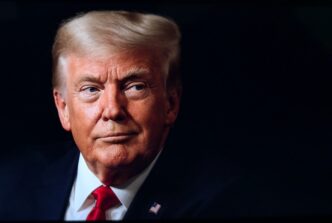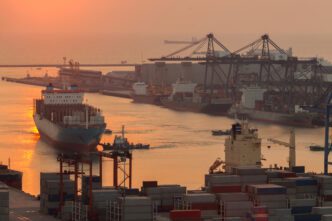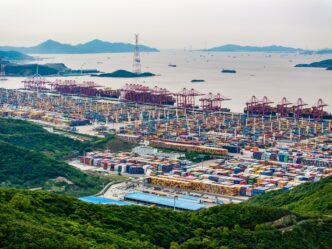President Trump’s tariff policy represents a significant shift in trade dynamics, impacting various sectors across the globe. Analysts once viewed these tariffs as mere threats, but their implementation marks a new economic era. This policy could have far-reaching implications for consumers and companies alike. With tariffs now active, the business world is bracing for immediate and long-term effects.
As the tariffs take effect, businesses are quickly adapting to the new landscape, preparing for potential economic shifts. Companies are assessing their supply chains and strategizing to mitigate the financial impact. The global market is responding, with stock indices showing volatility. These tariffs are not just numbers; they affect everyday economics, influencing prices and consumer behavior.
Immediate Impact on Global Markets
The announcement of tariffs led to an immediate dip in stock markets worldwide. U.S. indices like the Dow and Nasdaq saw significant drops, while European and Asian markets followed suit. This market turmoil is attributed to increased fears of a trade war, as tariffs often lead to economic uncertainty. Investors are concerned about rising costs and potential supply chain disruptions, prompting a rush to reassess portfolios.
Rising Costs and Consumer Prices
Tariffs have a direct impact on import costs, which are typically passed on to consumers. As businesses face higher expenses, prices on goods from everyday items to industrial products are expected to rise. Initially, the price increase may be slow due to pre-existing stock, but as inventories deplete, consumers will likely notice changes. This scenario is particularly troubling for inflation-conscious shoppers.
Retailers are in a precarious position, needing to balance absorbing costs and maintaining customer loyalty. The risk of price hikes could drive consumers to seek alternatives, affecting brand loyalty and sales. Companies must navigate these challenges while attempting to protect profit margins.
Sectoral Challenges
Various industries are set to experience different challenges under the new tariff regime. The auto industry, heavily reliant on parts from Mexico and Canada, faces potential disruptions. Companies like GM and Ford are already witnessing stock fluctuations. Energy sectors also feel the pressure, as tariffs on Canadian exports raise concerns about increased fuel costs. Businesses in these fields must innovate to adapt.
The tech sector is not immune, with companies worried about component costs and global competition. This could lead to a shift in production strategies, with more emphasis on domestic supply chains to avoid tariffs and ensure stability.
Economic Arguments and Counterarguments
Supporters of the tariffs argue that they strengthen national security and encourage domestic production. They cite potential long-term benefits, such as reduced dependency on foreign goods. However, critics warn of inflation and potential recessionary impacts, questioning the broader economic benefit.
Economists are divided, with some believing the tariffs are a necessary step toward balanced trade. Others fear they could exacerbate existing economic issues. The debate continues as stakeholders weigh short-term pain against hypothetical long-term gains.
Corporate Responses and Strategies
Corporates have swiftly responded to tariff announcements, exploring strategies to manage increased costs. Many are considering relocating production to mitigate tariff impacts. Some industries are turning to technology and automation to enhance efficiency and reduce reliance on imported goods.
This strategic shift may not be feasible for all, requiring significant investment and adjustment. Yet, it’s seen as a proactive approach to future-proofing businesses against volatile trade policies.
Government and Policy Implications
The U.S. government faces challenges in managing trade relations while supporting domestic industries. Retaliatory tariffs from other nations add complexity. Policymakers are under pressure to balance national interests with global partnerships, aiming to mitigate negative impacts on the economy.
Government intervention, such as subsidies or tax incentives, might be necessary to support affected sectors. These measures could provide temporary relief but also raise questions about long-term sustainability and fiscal responsibility.
The Future of International Trade
The tariff policy raises questions about the future dynamics of international trade. Analysts predict a possible shift towards bilateral agreements as countries reassess trade partnerships. This could redefine global supply chains, encouraging more regional trade agreements to circumvent tariffs.
There is a potential for increased diplomacy and negotiation as countries innovate to maintain economic stability. The path forward may require nations to explore new alliances to secure trade routes and markets.
Expert Opinions
Market experts emphasize the need for cautious optimism. While acknowledging potential benefits of a redefined trade landscape, they caution against underestimating tariffs’ immediate challenges. The consensus is that businesses must remain agile, adapting swiftly to changing conditions.
Although some predict a short-lived tariff phase, uncertainty looms. Companies flexible in strategy and operation are more likely to navigate the turbulent times ahead.
Consumer Outlook
Consumers face the challenge of adjusting to potential price hikes and shifting market conditions. Budget-friendly shopping and prioritizing essentials become more critical. This climate urges consumers to remain informed and proactive regarding shopping choices.
Awareness and adaptability will be key, as individuals make purchasing decisions amid ongoing economic fluctuations. Consumers are advised to watch market trends closely and adjust spending to maintain financial stability.
In navigating Trump’s tariff policy, businesses and consumers must brace for economic shifts and remain adaptable. This period of uncertainty demands strategic planning and resilience. As the global market faces disruption, focus on sustainability and innovation may guide future trade practices.








